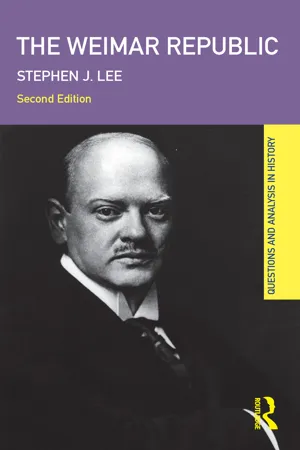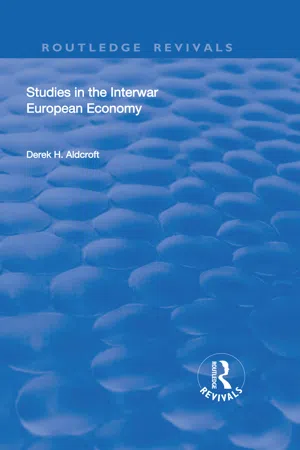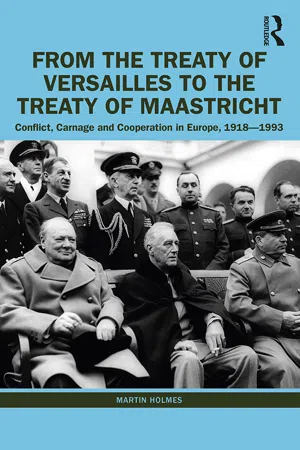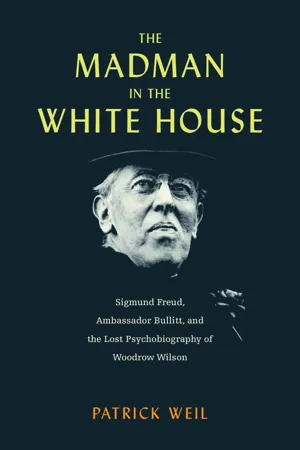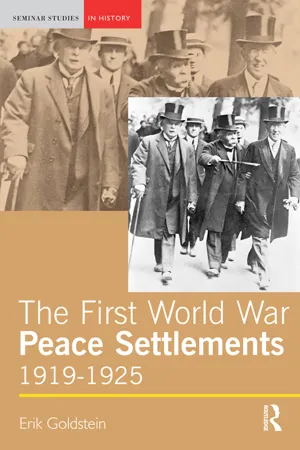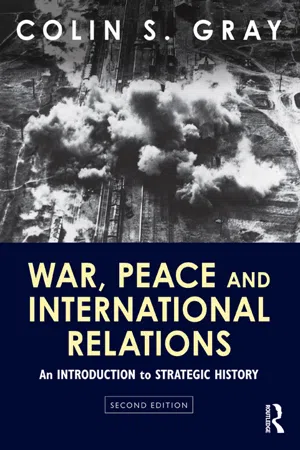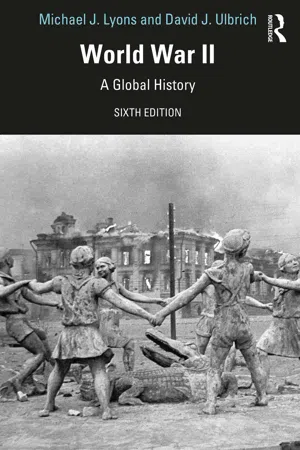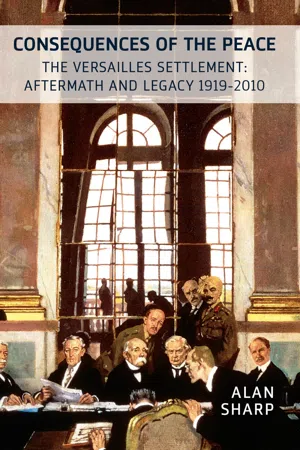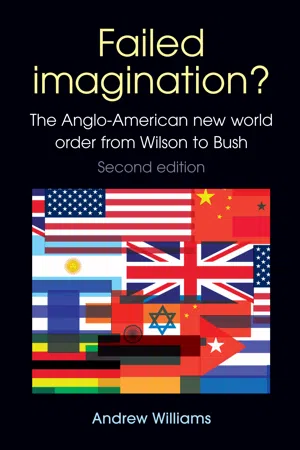History
Treaty of Versailles and the USA
The Treaty of Versailles was the peace agreement that officially ended World War I. The United States played a significant role in the negotiations but ultimately did not ratify the treaty. The U.S. Senate rejected the treaty due to concerns about the League of Nations and the potential impact on American sovereignty.
Written by Perlego with AI-assistance
Related key terms
10 Key excerpts on "Treaty of Versailles and the USA"
- eBook - ePub
- Stephen J. Lee(Author)
- 2013(Publication Date)
- Routledge(Publisher)
2VERSAILLES AND ITS IMPACT, 1919–33
BACKGROUND
Germany signed an armistice with the Allies on 11 November 1918. From this point onwards, negotiations for a peace settlement were carried out between the Allies in Paris, within the format of the Council of Ten. Most of the work was done by President Wilson of the United States, Lloyd George, the British Prime Minister, and Clemenceau, the French Premier. A preliminary draft of the arrangements concerning Germany was sent to the German government, but any attempts made by the new Republic to change the terms were rejected.The Treaty of Versailles was signed on 28 June 1919. It affirmed, by Article 231, the responsibility of Germany and her Allies for the outbreak of the First World War and accordingly made provision tor territorial adjustments, demilitarisation and economic compensation to the victorious Allies for the losses they had incurred. Germany was deprived of Alsace—Lorraine, Eupen and Malmédy, Northern Schleswig, Posen, West Prussia, parts of southern Silesia, and all her overseas colonies. Limits were placed upon her naval capacity, her army was restricted to 100,000 volunteers, and the Rhineland was demilitarised. A considerable quantity of rolling-stock and merchant shipping was also removed, while France was given exclusive rights to the coal mines in the Saar region. Finally, provision was made for the payment of reparations by the German government, the total amount eventually being fixed in 1921 at 136,000 million gold marks.The terms caused considerable resentment within Germany and contributed to the spiralling inflation which undermined the economy between 1921 and 1923. Attempts were made to regularise the payment of reparations by the Dawes Plan (1924) and the Young Plan (1929); the result was to spread the load, extend the deadlines and provide American investments. Following the impact of the Great Depression, most of the reparations were finally cancelled at Lausanne in 1932. The military and territorial terms of the Treaty were undermined by the unilateral action taken by Hitler after 1933. - eBook - ePub
- Derek H. Aldcroft(Author)
- 2019(Publication Date)
- Routledge(Publisher)
CHAPTER ONEThe Legacy of the Versailles Settlement
Though the First World War caused much loss of life, destruction and devastation which rendered Europe virtually destitute by the latter half of 1918, it can nevertheless be argued that the immediate consequences of more than four years of hostilities were less important than the postwar settlement in determining the longer-term future of Europe. Keynes, in his vitriolic denunciation of the peace treaty with Germany, recognised its defects in regard to the future of Europe (Keynes, 1920, p. 211), but the postwar settlement had far wider connotations than he envisaged at the time of writing. The term Versailles settlement used here therefore embraces not only the formal peace treaties with the enemy powers, but also the varied clearing-up operations which arose such as the question of reparations and war debts, the arrangements for relief and reconstruction, the establishment of the League of Nations, together with the role of the United States in postwar Europe. The position of the United States assumes significance because it emerged from the war as the most powerful nation in the world. While it replaced Europe as the potential leader in world affairs, in practice the United States exercised this role reluctantly, quickly making a political and military retreat from European affairs as isolation took hold, though maintaining an arms-length economic interest until the great depression. Europe, on the other hand, failed to recapture its former preeminence partly because the postwar settlement precluded that possibility, even though European leaders played a major role in designing that settlement, and partly because American policy indirectly worked against Europe’s revival. - eBook - ePub
From the Treaty of Versailles to the Treaty of Maastricht
Conflict, Carnage And Cooperation In Europe, 1918 – 1993
- Martin Holmes(Author)
- 2022(Publication Date)
- Routledge(Publisher)
1The legacy of the Versailles Treaty
DOI: 10.4324/9781003260998-2Over a century has passed since the 1919 signing of the Versailles Treaty. The consensus view that it had failed was rapidly established in the 1920s and has endured to this day. Because of its negative consequences, the Treaty has acquired a reputation as fundamentally misconceived ‒ a textbook example of how diplomacy, however well intentioned, can implode in spectacular fashion. British historian A.J.P. Taylor, writing in the 1960s, stated that the Treaty of Versailles ‘lacked moral validity from the start’.1 And that was not the only criticism. Many other scholars have argued in the intervening years that the Treaty was completely unrealistic and impractical, reorganising the map of Europe for the next war. Beyond doubt, the Treaty spawned rancour and discord that poisoned international relations in Europe after 1919.If ever a war deserved a concluding treaty to preserve the peace it was World War I. Costing around 20 million lives, many lost in the horrendous degradation of the trenches, the conflict was the worst in Europe since its appalling seventeenth-century equivalent, the Thirty Years’ War (1618–1648). If the Catholic versus Protestant origins of that war seem utterly senseless to the modern mind, the same can be said of the national power rivalries that ignited World War I. Every single life lost in both wars, three hundred years apart, was lost in vain. The Versailles Treaty could not bring back those lost, but it might have established the conditions for future peace. Tragically, it failed utterly.At its inception, however, the Treaty of Versailles certainly had its supporters. It was regarded as a new form of diplomacy, not least by those Americans who subscribed to President Woodrow Wilson’s diplomatic vision. In contrast to traditional treaties enshrining ‘victor’s justice’, it appeared to be highly enlightened, even utopian, though to its critics it contained the seeds of its own destruction. - eBook - ePub
The Madman in the White House
Sigmund Freud, Ambassador Bullitt, and the Lost Psychobiography of Woodrow Wilson
- Patrick Weil(Author)
- 2023(Publication Date)
- Harvard University Press(Publisher)
1 The American Collapse of the Treaty of VersaillesWHEN PRESIDENT WOODROW WILSON RETURNED to the United States on July 8, 1919, he was convinced that he would easily overcome all domestic opposition to the treaty he had negotiated in Paris. The peace, signed with Germany in the Hall of Mirrors of the Palace of Versailles, bore the strong imprint of the United States. Wilson’s Fourteen Points, the framework for a lasting peace that he had presented to the US Congress in January 1918, had been accepted by the Allies and by Germany. The restoration of Belgian sovereignty, the return of Alsace-Lorraine to France, the dismantling of the Ottoman Empire, the adjustments of borders in the Balkans and Italy—all these territorial dimensions of the Fourteen Points were integral to the Treaty of Versailles. The Austro-Hungarian Empire also disintegrated and was forced to recognize the independence of its peoples in accordance with the principle of self-determination that had become Wilson’s talisman.Finally, and above all, the League of Nations, the cornerstone of the Fourteen Points, was placed at the head of the treaty. Wilson was especially proud of this contribution, which he considered decisive for the stability and security of all states. The league would be a forum for adjudicating international disputes and would provide mechanisms for preventing war. In cases of military aggression, economic sanctions would be applied immediately, and league members would be enjoined to collective defense, putting their own forces on the line to protect any member states that had been attacked.Getting to this point hadn’t been easy. Hostilities had ceased with the armistice of November 1918, but Wilson aimed for much more: not just the formal end of the Great War, but an end to all wars, for all time. The American president had spent the entire spring of 1919 negotiating daily with the Italian, British, and French prime ministers—Vittorio Emanuele Orlando, David Lloyd George, and Georges Clemenceau. Along with Wilson, they comprised the so-called Council of Four or Big Four. The challenge was to draft a peace treaty that would secure a lasting peace while satisfying the Big Four’s security, territorial, and financial interests and obtaining Germany’s agreement. - eBook - ePub
- Henry Kissinger(Author)
- 2011(Publication Date)
- Simon & Schuster(Publisher)
CHAPTER NINE
The New Face of Diplomacy: Wilson and the Treaty of Versailles
O n November 11, 1918, British Prime Minister David Lloyd George announced that an armistice between Germany and the Allied Powers had been signed with these words: “I hope that we may say that thus, this fateful morning, come to an end all wars.”1 In reality, Europe was a mere two decades away from an even more cataclysmic war.Since nothing about the First World War had gone as planned, it was inevitable that the quest for peace would prove as futile as the expectations with which nations had launched themselves into the catastrophe. Every participant had anticipated a brief war and had left the determination of its peace terms to the sort of diplomatic congress which had ended European conflicts for the past century. But as the casualties mounted to horrendous proportions, they obliterated the political disputes of the prelude to the conflict—the competition for influence in the Balkans, the possession of Alsace-Lorraine, and the naval race. The nations of Europe came to blame their suffering on the inherent evil of their adversaries, and convinced themselves that compromise could bring no real peace; the enemy had to be totally defeated or the war fought to utter exhaustion.Had European leaders continued the practices of the prewar international order, a compromise peace would have been made in the spring of 1915. Offensives by each side had run their bloody course, and stalemate prevailed on all fronts. But just as mobilization schedules had run away with diplomacy in the week prior to the outbreak of the war, so now the scale of the sacrifices stood in the way of a sensible compromise. Instead, the leaders of Europe kept raising their terms, thereby not only compounding the incompetence and the irresponsibility with which they had slid into war, but destroying the world order in which their nations had coexisted for nearly a century. - eBook - ePub
- Erik Goldstein(Author)
- 2013(Publication Date)
- Routledge(Publisher)
Doc. 10].Conclusion
The Paris Peace Conference and the Treaty of Versailles proved to be only the first phase of attempts to reach a settlement to the myriad problems of international relations cast up by the First World War. It was concluded while the memories of that brutal conflict were still fresh and it is not surprising that the settlement imposed upon Germany contained harsh elements. Criticism of the treaty came swiftly. Notable among its critics was Keynes who resigned his Treasury job and published, in late 1919, The Economic Consequences of the Peace, which condemned the reparations clauses and predicted that they would only lead to greater instability through the problems it would cause in Germany and through attempts at enforcement of the reparations payments. In his passionately written critique Keynes warned that this harsh settlement would lead to ‘a civil war between the forces of reaction and the despairing convulsions of revolution, before which the horrors of the later German war will fade into nothing, and which will destroy, whoever is victor, the civilisation and the progress of our generation.’3 Later historians have disagreed with the view that the Versailles settlement was a Carthaginian peace. William Keylor has argued that Versailles, ‘was far from a Carthaginian peace, compared not only with the fate of ancient Carthage itself but more recently with the brutal treatement of defeated Germany at the end of World War II in the form of both territorial amputations and reparations.’4 - eBook - ePub
War, Peace and International Relations
An introduction to strategic history
- Colin S. Gray(Author)
- 2013(Publication Date)
- Routledge(Publisher)
status quo resulting from the frontiers between Germany and Belgium and between Germany and France, and the inviolability of the said frontiers as fixed by or in pursuance of the Treaty of Paris signed at Versailles on June 28, 1919’ (Article 1; quoted in Goldstein, 2002: 120).The peace settlement to World War I could not help but be a legacy from that long struggle to the future. Its terms and the ways in which they worked, and failed to work, depended wholly upon the dynamic political context and its associated strategic context. (The crucial changes in those contexts are examined in the next section.) The settlement satisfied no one. It humiliated and punished the Germans. In the view of the French it made no reliable provisions for their future security. In the eyes of the British it was unduly harsh on Germany, especially in its economic dimension. And it made unacceptable demands upon the Americans. They would not sign up for a League whose covenant was keyed to the principle of collective security, a principle that would require the United States to take action abroad, not always at its own discretion. It left Italy convinced that it had been short-changed in rewards for its wartime sacrifices. Rome had received promises of extensive territorial acquisition at the expense of Austria, Hungary, Turkey and even Germany. That was how London and Paris had bribed the country into belligerency in 1915. And, last but not least, Japan, a successfully opportunistic ally in the war, was thoroughly aggrieved by the failure of its allies and co-belligerents, especially the United States, to support its predatory demands upon China. However, this list of discontents was of no great significance in the 1920s. During that decade the political and strategic contexts placed strict practical limits upon the potential of discontented states to make trouble. The question of the 1920s, had anyone been minded to look to the future in this way, was whether the discontented parties would, or could, come to accept the post-war environment as being tolerably legitimate. As an aid to such acceptance, could they adjust the settlement to a meaningful degree before the course of strategic history staged some surprises and tested the stability of the existing order? - eBook - ePub
World War II
A Global History
- Michael J. Lyons, David J. Ulbrich(Authors)
- 2021(Publication Date)
- Routledge(Publisher)
Despite Wilson’s dream of the League safeguarding global democracy, the United States never joined the League because the U.S. Senate did not ratify the Treaty of Versailles. A dispute erupted between Wilson and Republican Senator Henry Cabot Lodge who refused to accept the League without guarantees of American sovereignty. Lodge and his fellow Senators did not want the United States to be forced by the League to go to war and fight under the League’s flag and auspices. The ever-stubborn Wilson refused to compromise regarding the League, and the Treaty of Versailles failed to obtain the two-thirds majority necessary for ratification in 1920.The British never shared Wilson’s enthusiasm for the League and now saw considerably less reason for optimism. The French viewed the League with outright skepticism. Of far greater concern to them, however, was the failure of the Senate to ratify the treaty. The French could not count on American support if Germany attacked them. The British subsequently used the American rejection as grounds for abandoning its commitment to France as well.Other Postwar Peace Treaties
After World War I ended, the Austrians and Hungarians severed their imperial ties and created two separate states when they signed the Treaty of St. Germain with Austria and the Treaty of Trianon with Hungary. The disintegration of their empire led to the formation of two other new nations: Czechoslovakia and the Kingdom of Serbs, Croats, and Slovenes (later called Yugoslavia). Neither of these conglomerates of diverse languages, ethnicities, and religions offered much hope for solving disputes among their constituent groups.Czechoslovakia based its independence on a union of the Czechs, who lived in the western provinces of Bohemia and Moravia, with the Slovaks, who inhabited the eastern area of Slovakia. The Czechs enjoyed a considerably larger population and better political and economic institutions, so they dominated the new state. The country also included German, Hungarian, and Ruthenian minorities. Of these marginalized groups, some three million Germans resided in the frontier areas of Bohemia and Moravia in a region known as the Sudetenland. - eBook - ePub
The Consequences of the Peace: The Versailles Settlement
Aftermath and Legacy 1919-2015
- Alan Sharp(Author)
- 2015(Publication Date)
- Haus Publishing(Publisher)
1The Peace Settlements: Versailles, an Overview
In 1914 certain key decision-makers in Europe, particularly those in Berlin and Vienna, decided that the current international order must be remade, even if that required employing the risky and unpredictable method of war. The conflict they provoked was not the short, sharp, successful war they anticipated and its consequences were much deeper and longerlasting than they imagined or intended.The Second World War would be an even greater conflict in terms of costs and geographical reach but there can be no doubt that the seminal event of the 20th century was the First World War. It consumed more men, munitions and material than anyone in 1914 had believed possible. Governments were forced to take responsibility for aspects of the economy, finance, production, transport and supply far beyond any previous experience. The cost of the war was astronomical and shattered previously held ideas of how much credit governments could raise. In 1917 and 1918 the United States alone spent more money than the accumulated total for all federal expenditure since independence.On both sides of the lines women took the place of men in industry, agriculture, offices and commerce, creating increased expectations about the types and conditions of employment open to them, the facilities to which they were entitled in the workplace and their future political role. The war became a test not simply of military prowess but of the ability of governments to respond to the challenges of total war – war that required the state to commit not just its armed forces but the entirety of its resources to the task. Those that failed experienced defeat and revolution in varying degrees of intensity. Some of the victors had a greater chance to control the pace of social change but victory did not guarantee the survival of the existing political structures of the state, as Italy would soon discover. No matter how much people might wish to return to what President Warren G Harding termed ‘normalcy’, the world of 1914 was shattered and could not be resurrected. - eBook - ePub
Failed Imagination? -second edition
The Anglo-American new world order from Wilson to Bush
- Andrew Williams(Author)
- 2013(Publication Date)
- Manchester University Press(Publisher)
They either felt ignored, like Lord Bryce, 68 or callously overruled, like Keynes, or slighted, like Hankey. In the longer term, virtually the entire discussion on the post-war settlement during the Second World War, particularly in the United States, was premised on a need to understand the ‘lessons’ of the Versailles settlement. Hamilton Fish Armstrong, by the end of the 1930s editor of Foreign Affairs and a prominent member of the State Department’s Post-War Planning (PWP) Committees that will be described in the next chapter, believed that ‘[a] critical analysis of the Armistice of 1918 might well be one of the first studies undertaken by the [State Department] Committee [for PWP]’. 69 The physical presence of so many US personnel at Versailles and their subsequent involvement in Second World War PWP is itself a gauge of the continuity of thinking about the future of international relations and the United States’ place in it. Berle, Bowman and many others within the State Department, as well as many others involved in PWP in some way, such as Dulles, were all concerned not to make the same mistakes twice. Dulles considered as late as February 1944 that the Treaty had been ‘excessively harsh’ on Germany, but all agreed with him that they needed a ‘treaty which we can expect will be in force, not for a year or two, but twenty five years after it is made’. They were also concerned, like Dulles, not to allow isolation and power politics of the ‘particular kind’ practised by the European powers, including Britain and Russia, to prevail: ‘[t]his time it is up to us to make it clear first because we were the ones who ran out on them last time’. 70 Within the Roosevelt Administrations after 1933 the received wisdom came to be that ‘the mistakes of that Treaty had been mainly economic’, especially for Cordell Hull, who dedicated most of his career to righting that omission
Index pages curate the most relevant extracts from our library of academic textbooks. They’ve been created using an in-house natural language model (NLM), each adding context and meaning to key research topics.
